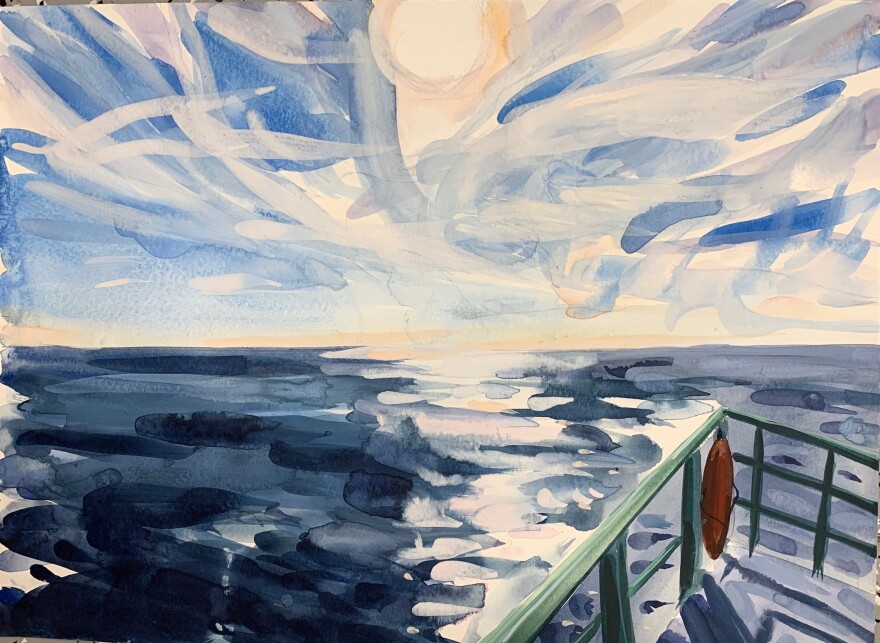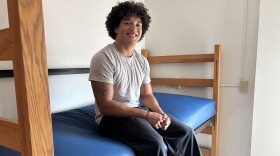In 2019, New Hampshire artist Wendy Klemperer was offered a unique opportunity: become an artist at sea with a scientific research team. The team was led by Dr. Jennifer Miksis-Olds, director of the Center for Acoustics Research and Education at the University of New Hampshire.
The resulting artwork from her time aboard the ship is now on display at the UNH Museum of Art. Wendy Klemperer and Dr. Jennifer Miksis-Olds joined NHPR Morning Edition host Rick Ganley to discuss their interest in collaborations between artists and scientists.
Transcript:
Dr. Jennifer Miksis-Olds: So the purpose of this project was to understand the soundscape, or what it sounds like, underwater and the oceanographic parameters because this was an area that had been thought to be useful for oil and gas energy exploration and now renewable energy. So there's the potential to have a lot more energy development in this area. And our project was really tasked with understanding those baseline conditions.
Rick Ganley: So why were you interested in bringing an artist on board?
Dr. Jennifer Miksis-Olds: Wendy is our second artist that has joined us on this project and having an artist on board those two things. We're able to see things through their eyes that we wouldn't have normally seen or paid attention to. And I've also found that artists can capture aspects of science that appeal to the general public in ways that no scientific papers or presentations just don't get out there. There's a beauty and value of the science we do that artists are much better able to capture sometimes than the technical content.
Rick Ganley: There's a history of artists joining scientific voyages, but not so much, I think, in recent years. Wendy, you've got a background, I understand, in biochemistry, but had you ever done a trip like this before?
Wendy Klemperer: No, I hadn't, but I've always been fascinated and attracted to the idea of the artist as explorer and adventurer alongside scientists. But for me, it was this totally new adventure.
Rick Ganley: So what was your medium primarily?
Wendy Klemperer: Well, normally my medium is large-scale welded metal sculptures, but that wasn't really feasible on the ship. My primary medium was watercolor and also pencil and ink. The site that I ended up working [at] was in the wet lab, which is where they would gather the specimens of zooplankton collected in the nets, and they would look at them under the microscope. But that would usually happen late at night, and so I was able to use the wet lab as a painting studio for certain hours during the day and early evening.
Dr. Jennifer Miksis-Olds: Wendy did share her art with the entire ship because we had an impromptu art show of all of the things she had done on the ship, where we mounted them to the main corridor wall for a day or two before we hit port. And it was great to see every member of that boat stop and look at all the different types of artwork. It was the most social I had seen on the boat our entire three weeks, because people from different shifts spent the time to talk to people from other shifts that were looking at the art. So it was really great to see the social aspect and the interest that that little art show on board promoted.
Wendy Klemperer: Some people just don't see each other because you're on these 12-hour shifts, and if you're not on the same shift, you just don't see each other. And you know, certainly the scientists mingle more with the scientists and the crew, more with the crew. And so that was a really nice networking thing, our little art opening.
Rick Ganley: Jennifer, did Wendy's artwork illuminate anything about your work or research?
Dr. Jennifer Miksis-Olds: For me, I think the most profound aspect [was] the fact that she did portraits of all different sectors of people on the ship. It really highlighted elements of science that I often either take for granted, because I'm so focused on the research, or overlook or underappreciate. Wendy's ability to capture that humanity of all the people on the ship that work together to enable the science really, you know, hit me strongly that at sea, ocean science is a team sport.
Every person that Wendy captured in her portfolio of portraits was essential to the science: from the cooks who took such good care of us, to the engineers that kept the lights on and the engines running and the boat moving to the captain, the mates, who helped us navigate from site to site. A lot of times it's the research that gets the PR, but really it's a team sport. You know, we couldn't do that without the science crew and the engineering crew, and Wendy brought that out front and center. And that, I think, was the most profound and advantageous element that I took from Wendy being out there.
Rick Ganley: Well, Wendy, what about for you? How did this experience impact your art and your creative process?
Wendy Klemperer: Well, after the ship trip, I started doing these watercolors of fish during the early phases of COVID when I was sort of in lockdown. And I think that the fish imagery came from the trip. I'm not sure, but I think it did. And then that led to a whole suite of watercolors. And now I'm doing these cutouts of fish using a plasma cutter, cutting out of scrap steel, and it's a really exciting body of work. So one way or another, I think the trip contributed to some exciting new work for me.
Rick Ganley: Jennifer, do you think there should be more opportunities like this for scientists and artists to collaborate?
Dr. Jennifer Miksis-Olds: I think it's great. Every time we have an artist collaborate with us or come out into the field with us, I learn something new about the science, I learn something new about myself and even my field that we work in. And so, you know, we do Artists at Sea, but there's so many other aspects of science that artists could be included in, and I would wholeheartedly support that 100% every time, because it just makes what we do as science more approachable and palatable to a general public who might not understand science. So, yes, I would definitely support more artists and science collaborations.









